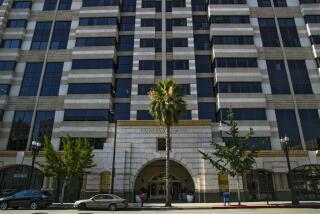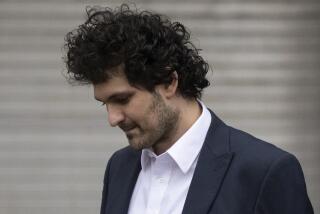Plaintiffs Backed by Brain Trust : Litigation: Enormity of investors’ case requires computers, millions of documents, even videotapes.
- Share via
TUCSON — The small brass nameplate states neatly, “Lincoln PLG,” and passersby could easily miss it near the door of the white stucco office building in downtown’s refurbished La Placita Village area.
Inside the freshly painted, plainly furnished offices, the brain trust of the Lincoln Plaintiffs Litigation Group plots the next move in the legal war they are waging on behalf of investors in the now-defunct American Continental Corp.
Joseph W. Cotchett Jr. of Burlingame is the chief trial lawyer. He has 27 years of experience battling corporations and insurance companies over alleged financial wrongs--like securities fraud.
Leonard B. Simon of San Diego, Ronald Rus of Orange and R. Clayton Janssen of Eureka will also be handling parts of the trial and, with Cotchett, form the top tier of lawyers calling the shots for the investors.
As many as eight other lawyers, headed by Cotchett partner Susan Illston, will be helping with legal briefs and other trial matters. Altogether, more than three dozen lawyers from 14 law firms worked for nearly three years to get the case ready for trial.
The task has not been easy since the company and its Lincoln Savings & Loan subsidiary in Irvine fell apart in April, 1989.
The law firms filed 15 class-action lawsuits for the investors against nearly 100 defendants, and they quickly found themselves mired in perhaps the biggest paper case ever: More than 30 million pages of documents have been made available.
“And we’ve probably seen only 25% of the documents,” Cotchett said. “I could only imagine what more we might find.”
The paper doesn’t include transcripts from 1,100 videotaped depositions, which were taken five at a time for more than a year and six a day for six additional months.
The back storeroom of the 6,500-square-foot La Placita office is the heart of the plaintiffs’ operation. That’s where innumerable boxes containing about 3 million pages of key documents are kept. A steel seven-shelf structure--about 6 feet wide by 12 feet high--holds more than 200 black binders: all of it an elaborate cross-index system to tell lawyers where documents are located.
Computers are linked by telephone to the litigation group’s main warehouse in Santa Ana, where information has nearly filled a 650-megabyte hard disk. That’s enough information to fill a volume of books totaling 455,000 single-spaced pages.
Two legal assistants and a documents manager have been hired full time to staff the Tucson office until the trial is over.
By the sheer enormity of the case, plaintiffs’ lawyers must form a coordinating group to work together, especially since the cases are consolidated for trial. The court appoints the lead counsel--Cotchett, Simon and Rus, in this trial--and their law firms carry the brunt of the work and reap the biggest share of attorney fees at the end.
To pay for expenses such as rent and salaries, the lawyers have put in several million dollars of their own money and received an additional court-approved $5 million from the settlements they have reached so far.
Groups of defense attorneys sometimes ban together to help each other on certain motions, but they mostly go their separate ways, said Stuart L. Kadison, a Los Angeles lawyer for defendant Arthur Andersen & Co., a major accounting firm. That’s because the allegations are usually different for each defendant, he said, and each likely has different defenses to raise.
While this is the biggest case for most attorneys on it, Simon was involved in one a few years ago that could rival it--the $2.25-billion municipal bond default on nuclear power plant construction in the Washington Public Power Supply System. That litigation settled for $800 million just before trial, coincidentally, in federal court in Tucson.
More to Read
Inside the business of entertainment
The Wide Shot brings you news, analysis and insights on everything from streaming wars to production — and what it all means for the future.
You may occasionally receive promotional content from the Los Angeles Times.










